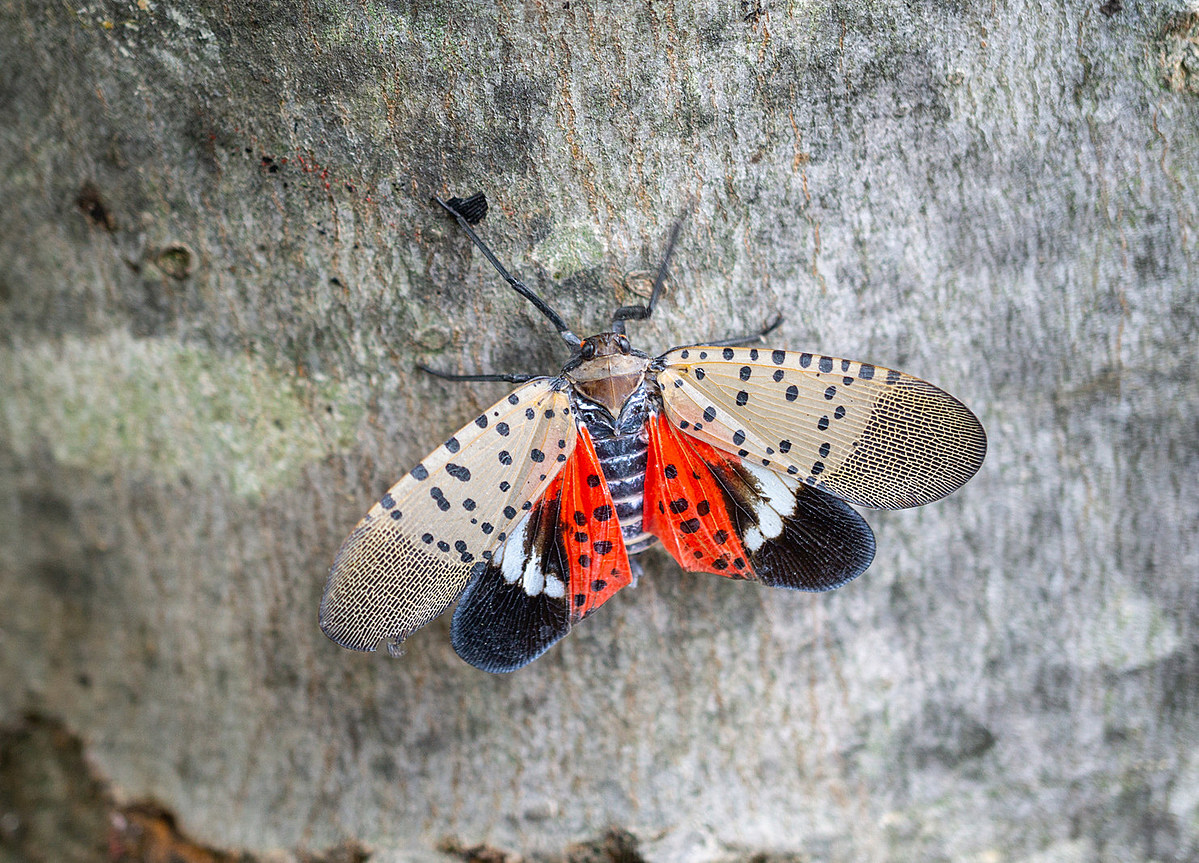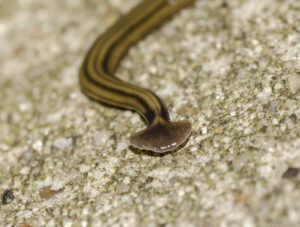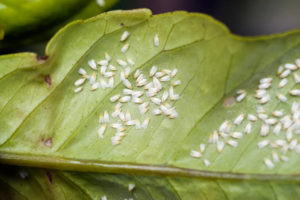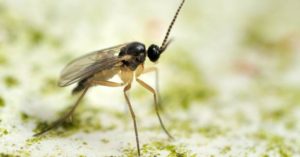The spotted lanternfly may not be an insect that is familiar to many of us, but it soon could be. This beautiful but destructive pest is an invasive species that is native to China, India, Vietnam, and eastern Asia. It was first observed in the United States in Pennsylvania in 2014, and then later in New York, Maryland, Virginia, and Delaware. Its presence poses a real threat to a number of important industries including, the fruit, logging, and wine industries.
How to Identify the Spotted Lanternfly
Although at first glance it may appear to be a moth, the spotted lanternfly is neither a moth nor a fly. It is actually categorized as a planthopper. It is capable of flying, but its strength lies in its ability to span large distances by jumping, the same characteristic found in leafhoppers.
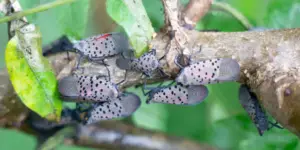
The adults measure about 1inch long and 1/2 inch wide (2.54 cm long by 1.27 cm wide). Their forewings are brownish-gray with black spots, while the hindwings, which aren’t clearly visible when the insect is at rest, are a striking red with black spots and a white band. Their head and six legs are black, and their abdomen is yellow with black bands. When they fly, both sets of wings are visible, causing them to sometimes be mistaken for small butterflies.
The nymphs, which measure between 1/8 to 1/2 inch (0.3 cm to 1.27 cm) long, depending on the stage of growth, start out black with white spots but develop red markings as they mature.
Life Cycle
In late summer to early fall, the adult female lays its brown, seed-like eggs in a cluster of 30 to 50 eggs. She coats the eggs with mud-like secretions that enable them to stick to any outdoor surface, including trees, plants, patio furniture, decks and awnings, sheds, cars, boats, homes, and woodpiles. The eggs will overwinter glued to these surfaces.
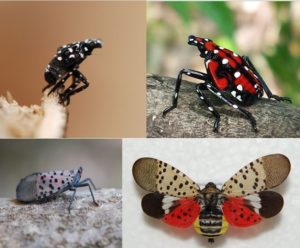
The nymphs will hatch in the late spring and progress through four instars or developmental stages. They will climb the host tree to feed and, if knocked down by the wind and rain, will return to the tree to resume feeding. The climbing and feeding cycle will continue until mid-summer when they reach adulthood. The adults will mate in the summer and then die, generally, in the late fall.
Damage
Thus far, there are over 65 species of plants and trees that have been identified as susceptible to the spotted lanternflies. Adults prefer the tree of heaven (a.k.a. Chinese sumac or stink tree) and willow trees but will feed on other host plants. The nymphs, on the other hand, will feed on a wide variety of plants and trees, their preferences changing as they mature. In addition to the tree of heaven and willow trees, nymphs also prefer maple, pine, and poplar, as well as ornamental trees such as dogwoods. They also feed on apple, plum, cherry, peach, apricot, and nectarine trees, in addition to feeding on grapevines, blueberries, flowers, and vegetable plants.
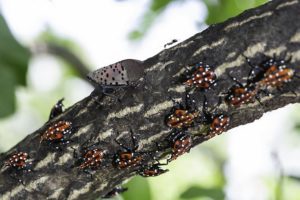
Because the spotted lanternflies move in swarms, their numbers can cause significant damage, such as oozing sap, wilted or curling leaves, and at least portions of the plant dying back. Like aphids, leafhoppers, and whiteflies, these sapsuckers excrete a sweet, sticky substance known as honeydew. Not only does the excretion attract other insects which feed on the honeydew, but it is also a magnet for black sooty mold, which is a fungus that can eventually kill the host plant.
Swarms of spotted lanternflies can also adversely affect those who enjoy outdoor living because they descend on people’s yards, covering their decks, furniture, and playground equipment, leaving behind sticky honeydew and attracting sooty mold.
This article contains affiliate links. If you make a purchase using one of these links, I will receive a very small commission at no additional cost to you, and it will help me maintain this website. Rest assured, I only recommend products I actually like!
How to Control Spotted Lanternflies
It is important to do what we can to stop this highly invasive species. Here are some of the most often recommended methods for eliminating spotted lanternflies:
Report any spotted lanternfly sightings to your local agricultural extension office, including adults, nymphs, or egg clusters.
Remove egg clusters. Starting in the fall through late spring, look for egg clusters on trees and other outdoor surfaces. If you find any, scrape them off with a knife into a container of soapy water, vinegar, or rubbing alcohol. Do not throw them away without first killing them, or they may hatch.
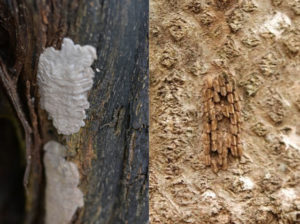
Kill nymphs and adults. When nymphs and adults feed on trees, you will typically see dark sap present. You may also notice a coating of honeydew or black sooty mold. Once the insects are located, you can kill them using organic methods. Since they congregate in large numbers, it may require employing more than one treatment method simultaneously to get rid of them.
Insecticidal soap can be an effective measure against both nymphs and adults. Some recommend making your own spray by mixing a Castile soap like Dr. Bonner’s with an equal amount of water in a spray bottle. When sprayed directly onto the insects, the solution will suffocate them. Do not be surprised if the insects fly or hop away. Just coat them with the spray as best you can.
Typically, before spraying a plant with a bug-killing solution, you would want to perform a test spray on a leaf and wait 24-48 hours to see how the plant responds. In addition, you would want to spray only in the early morning or early evening because the combination of sun and solution could damage plant tissue. However, in this type of situation, the lanternflies are already harming your plant and have the potential to harm even more if not dealt with immediately.
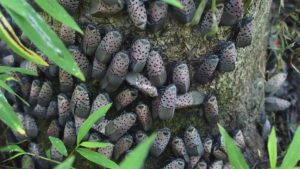
Vinegar Spray is also said to be an effective measure against this invasive pest. It is inexpensive and readily available. Simply add white vinegar to a spray bottle and spray directly on adults and nymphs. Again, it would be preferable to do a test spray if spraying plants, however, the situation may warrant that you spray the lanternflies immediately. You will need to decide what is the best option for your situation.
Neem oil, which is derived from the seeds of the Indian neem tree, contains a naturally occurring compound called Azadirachtin that works by either disrupting certain developmental hormones or by inhibiting feeding and egg-laying behavior. The lanternflies will not die right away, so patience is required for this method.
To make your own spray, add 4 teaspoons of neem oil, 2 teaspoons of a Castile soap like Dr. Bonner’s, and one gallon of water to a pump sprayer. Mix well and apply directly to the lanternflies. As mentioned above, you will need to use your discretion as to when and how to spray if plants are involved.
Some recommend adding several drops of peppermint oil or tea tree oil to the solution as an additional deterrent.
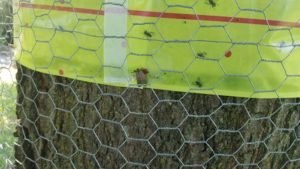
Sticky bands are narrow strips of sticky paper that, when wrapped around a tree trunk, are said to be an effective measure against the tree climbing nymphs. The bands, which can easily be purchased online, should be placed about four feet above the ground and wrapped tightly around the tree, making sure there are no gaps underneath the bands. You will need to replace the bands periodically.
It is important to note that sticky bands may accidentally trap other insects and possibly small birds and animals. One way to avoid this is to wrap chicken wire over the sticky band so that small animals and birds will be able to climb over the bands.
Circle Traps are another option for controlling lanternflies. The traps were originally designed to catch pecan weevils but have been shown to be effective in this application as well. As the spotted lanternflies move up the tree, they are guided by a circle of netting into the trap. These traps are not harmful to birds or small animals. In addition, the traps are reusable. You can purchase these online or make your own.
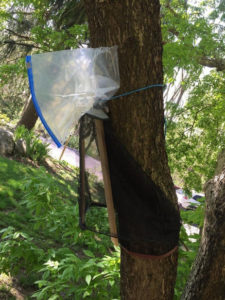
Trap Tree. A trap tree is any tree that attracts the nymphs or adult spotted lanternflies. If you are in Pennsylvania, New York, Maryland, Virginia, or Delaware, it is probably the tree of heaven (Chinese sumac or stink tree). Interestingly, thirty out of the forty-four states where this tree grows have declared the tree to be an invasive species. Authorities recommend removing 90% of the trap tree species on your property so that the lanternflies will seek out the remaining 10% making it easier to locate and then kill the insects.
Some areas in the above mentioned states are under quarantine, which means, among other things, that you are not allowed to remove the downed trees from the quarantined area. Consult local authorities for more information regarding any regulations.
Natural Predators. This non-native insect has no natural predators in the United States. However, some spiders, like the green lynx spider or wolf spider, may prey on them. In addition, assassin bugs, praying mantis, and other predatory bugs may help defray spotted lanternfly populations, but their effectiveness is going to be limited because the lanternflies migrate in large numbers.
In conclusion, the spotted lanternfly should be taken seriously. Keep an eye out for all stages of development from egg to adult, and be prepared to report their presence to your local extension office. Also, do what you can to eliminate this invasive species in your area.
Thank you for reading this article! If you found it helpful, please consider sharing it with others via email and social media!
